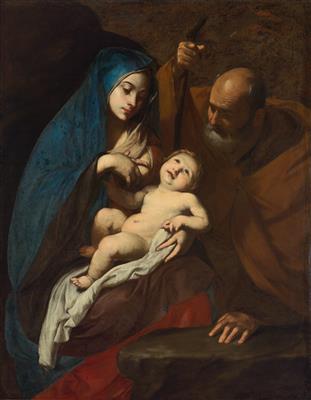Massimo Stanzione

(Orta di Atella circa 1585 – circa 1656 Naples)
The Holy Family
oil on canvas, 127.5 x 100 cm, framed
Provenance:
Private European collection
We are grateful to Sebastian Schütze for confirming the attribution after examination of the present painting in the original. He dates the painting to circa 1630–35.
With its spare composition, large-scale figures in full foreground and opaque colours, the present painting combines grace with gravity of expression. The simple palette, the intense blue and red of the mantle, the ivory tones of the flesh and the marked use of chiaroscuro are typical of Stanzione‘s style during this period. The picture retains a dramatic use of lighting and there is also an emphasis placed on symmetry and on dignified figures who convey their emotion through a studied language of gesture and expression.
From 1630 onwards Stanzione was almost constantly involved in large-scale church commissions in Naples. His work for the Carthusian monks in the church of the Certosa di San Martino includes the decoration of the chapel of Saint Bruno (circa 1630–37), the Pietà with Carthusian Monks (1638) and the large Last Supper for the choir of San Martino. The present painting displays affinities with two other compositions of similar subject, now in private collections in Rome and Genoa (see S. Schütze/T. C. Willette, Massimo Stanzione, L‘opera completa, Naples 1992, p. 205, nos. A36 and A37).
The rhetorical appeal of Stanzione’s graceful, idealizing style is fundamentally different from Caravaggio’s pointed naturalism. The lighting of his pictures, while less dramatic than those by Caravaggio or Ribera, owes much to these artists, but Stanzione seems not to have adopted their modes of representing human character. His alliance of natural hues and lighting with idealized forms is rather the result of his early study of Annibale Carracci’s paintings in Rome and Reni’s works both there and in Naples. His deep reds and blues, copper-greens and gold-yellows are ultimately indebted to Reni’s palette, as are the ivory hues he used for representing the flesh tones. Stanzione’s originality lies in the way he mastered particular qualities of these artists’ styles and brought them to bear in his own solution to the conflicting claims of ideal form and convincing naturalism.
20.10.2015 - 18:00
- Prezzo realizzato: **
-
EUR 37.500,-
- Stima:
-
EUR 30.000,- a EUR 40.000,-
Massimo Stanzione
(Orta di Atella circa 1585 – circa 1656 Naples)
The Holy Family
oil on canvas, 127.5 x 100 cm, framed
Provenance:
Private European collection
We are grateful to Sebastian Schütze for confirming the attribution after examination of the present painting in the original. He dates the painting to circa 1630–35.
With its spare composition, large-scale figures in full foreground and opaque colours, the present painting combines grace with gravity of expression. The simple palette, the intense blue and red of the mantle, the ivory tones of the flesh and the marked use of chiaroscuro are typical of Stanzione‘s style during this period. The picture retains a dramatic use of lighting and there is also an emphasis placed on symmetry and on dignified figures who convey their emotion through a studied language of gesture and expression.
From 1630 onwards Stanzione was almost constantly involved in large-scale church commissions in Naples. His work for the Carthusian monks in the church of the Certosa di San Martino includes the decoration of the chapel of Saint Bruno (circa 1630–37), the Pietà with Carthusian Monks (1638) and the large Last Supper for the choir of San Martino. The present painting displays affinities with two other compositions of similar subject, now in private collections in Rome and Genoa (see S. Schütze/T. C. Willette, Massimo Stanzione, L‘opera completa, Naples 1992, p. 205, nos. A36 and A37).
The rhetorical appeal of Stanzione’s graceful, idealizing style is fundamentally different from Caravaggio’s pointed naturalism. The lighting of his pictures, while less dramatic than those by Caravaggio or Ribera, owes much to these artists, but Stanzione seems not to have adopted their modes of representing human character. His alliance of natural hues and lighting with idealized forms is rather the result of his early study of Annibale Carracci’s paintings in Rome and Reni’s works both there and in Naples. His deep reds and blues, copper-greens and gold-yellows are ultimately indebted to Reni’s palette, as are the ivory hues he used for representing the flesh tones. Stanzione’s originality lies in the way he mastered particular qualities of these artists’ styles and brought them to bear in his own solution to the conflicting claims of ideal form and convincing naturalism.
|
Hotline dell'acquirente
lun-ven: 10.00 - 17.00
old.masters@dorotheum.at +43 1 515 60 403 |
| Asta: | Dipinti antichi |
| Tipo d'asta: | Asta in sala |
| Data: | 20.10.2015 - 18:00 |
| Luogo dell'asta: | Wien | Palais Dorotheum |
| Esposizione: | 10.10. - 20.10.2015 |
** Prezzo d’acquisto comprensivo dei diritti d’asta acquirente e IVA
Non è più possibile effettuare un ordine di acquisto su Internet. L'asta è in preparazione o è già stata eseguita.
